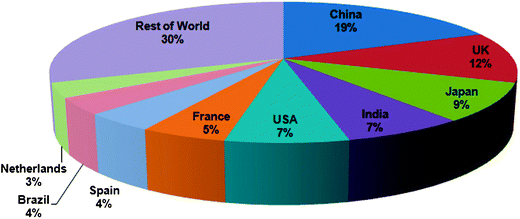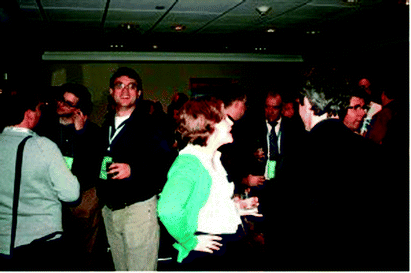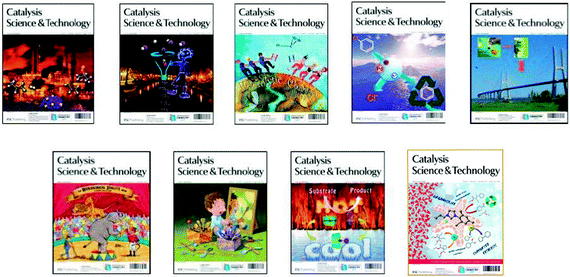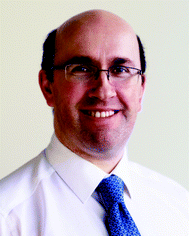Catalysis Science & Technology—What a difference a year makes!
It hardly seems like 12 months since we were preparing for the launch of the first published articles in Catalysis Science & Technology. Although we had opened for submissions in October 2010, it was only in the first month in 2011 that we started to plan for the first issue, including launch events, Editorial Board meetings and conference attendance.2011 was a busy year for the journal, with a number of significant achievements. These achievements would not have been possible without the support and direction given by the journal's two Editors-in-Chief, Professors Cynthia Friend (Stanford University, USA) and Piet van Leeuven (ICIQ, Spain). The year started very well, as we received in March the very positive news that Catalysis Science & Technology had been fast tracked for inclusion in Scopus. Since the journal successfully completed Thompson/ISI's selection criteria for inclusion in Web of Science in September 2011, readers can now find Catalysis Science & Technology via both platforms.
Since the first issue, published as the April 2011 issue, Catalysis Science & Technology has published 9 issues, containing 194 articles (36 reviews, 34 communications and 124 full papers), covering all areas of catalysis: Homogeneous catalysis, heterogeneous catalysis, organocatalysis and biocatalysis. Articles published in the journal in 2011 have come from 31 countries. The percentage contribution from these countries is shown in Fig. 1.
 | ||
| Fig. 1 Geographical contributions to Catalysis Science & Technology. | ||
Catalysis Science & Technology was launched with the aim to be a home for the best articles from all areas of catalysis, all brought together in one journal. We are very pleased with the high quality of the articles that have already been published in the journal. One measure of the high quality of published articles is the citation count for the articles already appearing in the journal and the most cited articles to date are given in Table 1.
| Two-dimensional zeolites: dream or reality, Wieslaw J. Roth and Jiri Cejka | Catal. Sci. Technol., 2011, 1, 43 DOI: 10.1039/c0cy00027b |
| A straightforward zinc-catalysed reduction of sulfoxides to sulfides, Stephan Enthaler | Catal. Sci. Technol., 2011, 1, 104 DOI: 10.1039/c0cy00039f |
| Activity improvement of gold yolk-shell catalysts for CO oxidation by doping with TiO 2 , Robert Guettel, Michael Paul and Ferdi Schüth | Catal. Sci. Technol., 2011, 1, 65 DOI: 10.1039/c0cy00026d |
| Superparamagnetic nanoparticles for asymmetric catalysis-a perfect match, Kalluri V. S Ranganath and Frank Glorius | Catal. Sci. Technol., 2011, 1, 13 DOI: 10.1039/c0cy00069h |
In 2011, Catalysis Science & Technology articles have also been highlighted in chemistry news magazines, including the RSC's Chemistry World and ACS's Chemical & Engineering News. Two such are articles highlighted in this way are:
Fe-TAML/hydrogen peroxide degradation of concentrated solutions of the commercial azo dye tartrazine, Evan S. Beach, Ryan T. Malecky, Roberto R. Gil, Colin P. Horwitz and Terrence J. Collins, Catal. Sci. Technol., 2011, 437, DOI: 10.1039/c0cy00070a and Oxidative esterification of 1,2-propanediol using gold and gold-palladium supported nanoparticles, Gemma L. Brett, Peter J. Miedziak, Nikolaos Dimitratos, Jose A. Lopez-Sanchez, Nicholas F. Dummer, Ramchandra Tiruvalam, Christopher J. Kiely, David W. Knight, Stuart H. Taylor, David J. Morgan, Albert F. Carley and Graham J. Hutchings, Catal. Sci. Technol., 2011, Advance Article DOI: 10.1039/c1cy00254f.
The journal has a number of Editorial Offices which are open for submitted manuscripts. The first of these were based in the UK, USA and Japan, with Associate Editors Professors Paul Kamer, Paul Chirik and Noritaka Mizuno, respectively. In November we opened the fourth Editorial Office, that of Professor Javier Perez-Ramirez, ETH, Switzerland, reflecting the impressive growth that we have seen in submitted articles. The Associate Editors are joined on the Editorial Board by a number of world-class scientists: Professors David Jackson (Glasgow University, UK), Stan Golunski (Cardiff University), Deryn Fogg (University of Ottawa, Canada), Kuiling Ding (Shanghai Institute for Organic Chemistry, China), Axel Knop-Gericke (Fritz-Haber Institute of the Max Planck Society, Germany), and Johannes de Vries (DSM Innovative Synthesis BV/University of Groningen, The Netherlands). All Editorial Board members contribute to setting the scientific direction and standards of the journal.
We celebrated the journal at a number of events through the year, sometimes in the form of poster prizes, sometimes launch parties. We started the conference season with a celebration at the ACS Spring National meeting in Anaheim, CA, USA (Fig. 2), and this was then followed with a reception at the 16th IUPAC International Symposium on Organometallic Chemistry Directed Towards Organic Synthesis (OMCOS), Shanghai, China, in Shanghai. The reception at the ACS Spring meeting was very well attended (standing room only) and during the evening, Associate Editor Professor Paul Chirik addressed the audience and at OMCOS Editorial Board member Kuiling Ding introduced the Catalysis Science & Technology sponsored lecture by Ei-ichi Negishi.
 | ||
| Fig. 2 Celebrating Catalysis Science & Technology at the Spring ACS meeting. | ||
We were very pleased to support younger members of the research community with a number poster prizes throughout the year. Congratulations to the following Catalysis Science & Technology poster prize winners in since the launch of the journal: Toritse Bob-Egbe, Imperial College London, UK (Dalton Discussion 12: Catalytic C–H and C–X Bond Activation), Helen Daly, from Queens University Belfast (Applied Catalyst Deactivation hosted by the RSC Applied Catalysis Group), Zhao Chao, University of Birmingham (34th Annual British Zeolite Association Conference), Antonio Feula, University of Birmingham (Catalysis and Sensing for our Environment symposium), Thomas Dröge, University of Münster (OMCOS) and Carolin Ziebart, Leibniz-Institut für Katalysee. V., Rostock, Germany, (International Symposium on Relations between Homogeneous and Heterogeneous Catalysis).
We have had a busy first year for the journal (see Table 2) and it has been a delight to see the excellent articles and issues published (Fig. 3). Thank you for all your support for our new journal, as readers, authors and referees. I look forward to another busy 12 months!
| July 2010 | Journal announced |
| August 2010 | Editor-in-Chief Professor Piet van Leeuwen appointed |
| October 2010 | Two Associate Editors appointed: Professors Paul Chirik and Noritaka Mizuno |
| October 2010 | Journal opened for submissions |
| November 2010 | A third Associate Editor appointed: Professor Paul Kamer |
| December 2010 | Editor-in-Chief Professor Cynthia Friend appointed |
| January 2011 | First Advanced Articles published |
| March 2011 | First issue published |
| March 2011 | Fast track acceptance for inclusion in Scopus |
| March 2011 | Launch event at Spring ACS meeting, Anaheim, CA, USA |
| April 2011 | First Editorial Board meeting |
| July 2011 | Launch event at 16th IUPAC International Symposium on Organometallic Chemistry Directed Towards Organic Synthesis, Shanghai, China |
| August 2011 | Sponsored event at EuropaCat, Glasgow, UK |
| September 2011 | Journal accepted for inclusion in Thomson Reuters Web of Knowledge |
| November 2011 | Fourth Associate Editor office opened: Professor Javier Perez-Ramirez |
| December 2011 | First Catalysis Science & Technology themed issue published: Heterogeneous catalysis for fine chemicals |
 | ||
| Fig. 3 Cover artwork for the first 9 issues of Catalysis Science & Technology. | ||
Jamie Humphrey
Managing Editor, Catalysis Science & Technology
 | ||
| Plate1 Jamie Humphrey | ||
News from RSC Publishing
RSC Publishing growth and successes
Journals from RSC Publishing are delivering impressive results on Impact Factors, growth in quality content and international visibility and influence. The 2010 Journal Citation Reports® proved that our quality is better than ever, and that is thanks to our authors and referees. Of the top 20 journals in the multidisciplinary chemistry category, 25% are from RSC Publishing. Plus 83% of our journals listed in this year's report have an IF above 3.The number of articles published in our journals has almost doubled in just two years—and our share of the total has also nearly doubled in that time. More titles have recently joined our portfolio: RSC Advances and Catalysis Science & Technology. And Chemical Science received the ALPSP Award for Best New Journal 2011.
So more and more authors—from 70+ countries in 2011—are trusting us to ensure their research is communicated to the global community. Our Editorial and Advisory Boards are international, and our publishing operation is supported by offices in USA, China, India and Japan. Plus our content is downloaded by growing numbers of readers in virtually every country in the world.
These facts demonstrate that RSC journals are increasingly valued as a key resource for the very best research. www.rsc.org/journals
Books delivering the latest research advances, information, opinions and perspectives in modern science, confirms our reputation as one of the fastest and most dynamic publishers in the world.
In an age where content is key, we understand the importance of your online chemical science resource. The RSC eBook Collection now holds more than 1,000 books, equating to over 25,000 chapters, and spanning more than 40 years. The publication of our 1000th eBook in 2011 was a celebratory milestone.
We continue to provide expert, interdisciplinary chemical science books: over 100 new print titles are planned for 2012 alongside the launch of several new series including:
• Food and Nutritional Components in Focus
• New Developments in Mass Spectrometry
• New Developments in NMR
• RSC Smart Materials
Our ability to deliver fast, accurate information to our customers was rewarded by the BIC Basic Award, an accolade held by few publishers. www.rsc.org/books
RSC publishing platform
Access one million journal articles and book chapters in one simple integrated search.The RSC Publishing Platform provides the most valued interface and features that connect you with the highest quality scientific research. With one single search box, students, academics, researchers, scientists and professionals can easily access our books, journals and databases. www.rsc.org/platform
To access content on the go, download our RSC Mobile app for your electronic device. www.rsc.org/rscmobile
Free online access
Free online access is available to all our newest journals, and much more—all you need to do is register for an RSC Publishing Personal Account. Once logged in, you will be able to access all our free content including:• All content of our newest journals for the first two volumes
• Any articles that are part of a special free access promotion (e.g. ‘hot’ papers, web theme issues, etc.)
• A sample chapter from each book in the RSC eBook Collection
With your username and password you can access free content any time, any place—all you need is internet access. You can also save searches and favourite articles. Register now at www.rsc.org/personalregistration
If your institution/organisation is a current customer or on a free trial with IP registered addresses, you will be able to access all free content automatically, if authenticated. To request free access for your institution/organisation, go to www.rsc.org/freeaccess.
ChemSpider: the free chemical database
www.chemspider.com gives you the most comprehensive view of freely available chemical data from a single online search.Search: over 26 million structures from 400+ sources
Discover: related information from RSC publications, Wikipedia, Google Scholar & PubMed
Share: add and curate data
Access ChemSpider anytime, anyplace, anywhere with the free ChemSpider mobile app, www.rsc.org/ChemSpidermobile
ChemSpider SyntheticPages is a freely available interactive database of synthetic chemistry. It contains practical and reliable organic, organometallic and inorganic chemical syntheses, reactions and procedures deposited by synthetic chemists. Synthetic methods on the site are updated continuously by chemists working in academic and industrial research laboratories. ChemSpider SyntheticPages encourages submissions from graduate students, postdocs, industrialists and academics.
Discover ChemSpider SyntheticPages today: http://cssp.chemspider.com
RSC Conferences and Events 2012
The RSC organises a broad range of conferences and events to promote the advancement of the chemical sciences. Please visit the website for the most up to date listing: www.rsc.org/eventsThe major scientific meetings planned for 2012 include:
Challenges in Inorganic and Materials Chemistry (ISACS8)
19–22 July 2012, Toronto, Canada
Challenges in Nanoscience (ISACS9)
31 August–3 September 2012, Xiamen, China
21st IUPAC International Conference on Physical Organic Chemistry (ICPOC 21)
9–13 September 2012, Durham, UK
Inorganic Photophysics and Photochemistry – Fundamentals and Applications (Dalton Discussion 13)
10–12 September 2012, Sheffield, UK
| This journal is © The Royal Society of Chemistry 2012 |
